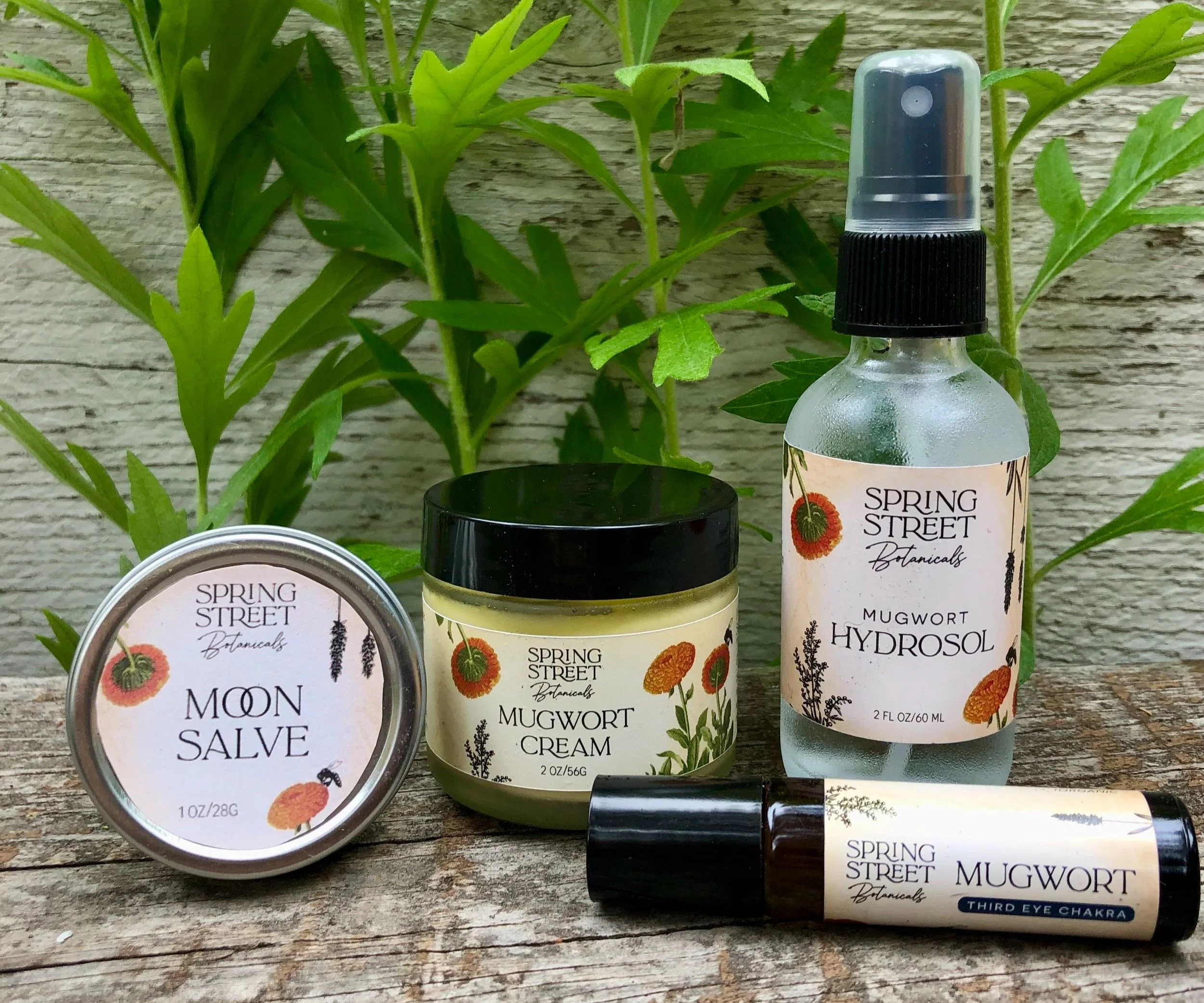Spotlight on Mugwort
Mugwort: It's time.
It’s time to introduce you to Artemisia douglasiana, aka California mugwort. Mugwort was the first herb I met here in California, inspiring me to follow the plant path these twenty-six years, and counting.
I had been cleaning the bathroom one spring afternoon when a friend stopped by to invite me for a walk around Fitch Mountain. I dropped the sponge, changed my clothes, and off we went. When we reached the north side of the mountain, she paused, plucking a few silvery-green leaves and rubbing them between her fingers to release the scent, she offered them to me. I sniffed. I swooned. What is this? A sweet sage? A spicy mint? I gathered myself and went in for more. It’s what mugwort does to me every time. It beckons. It calls softly, but irresistibly. It’s hard to describe. So layered, and nuanced, it begs consideration. Mugwort holds an otherworldly quality, quietly asking for attention, which is then reflected back to us, and we are connected more intimately to ourselves, to our intuition, to the wisdom of our dreams.
Mugwort will take your hand and lead you on a journey. I spent the month after that walk collecting and drying mugwort to stuff into dream pillows sewn with silk from a bag of abandoned saris. In my experience, mugwort dreams are not necessarily sweet dreams, but more therapeutic in nature, digging in and pulling up what needs to be looked at. Mugwort dreams help us understand situations that may previously have hindered our growth. Mugwort dreams make going to sleep early worth it.
Fast forward to 2021 and find me at the California School of Herbal Studies, learning to infuse oils, extract properties in alcohol, stove-top distill for hydrosols, and then emulsify these together into creams. The Mugwort Cream was born. I had to—had to—highlight this fine weed. The scent that emerges from this process is like a mist from the banks of the Russian River, simultaneously providing a softening that occurs when we feel grounded, and a strengthening we feel when we’re protected.
Mugwort circulates the blood, easing tension of both the muscular and nervous systems through its warming properties. It is used in womb salves and massage oils to relax both smooth and skeletal muscles. A traditional herb for women, mugwort supports the menstrual cycle, and is not recommended for use during pregnancy.
Anti-inflammatory in nature, I’ve also slathered the cream onto a few itchy spider bites and felt instant relief. A native land tender taught me to chew the leaf and use that as a poultice on poison oak rashes. A very bitter herb to chew, making tea and using that as a wash is another way to ease the itch from these rashes. Before you pluck a leaf or two, make sure it hasn’t grown up through poison oak or, if you’re sensitive to urushiol, that may be enough contact to cause the rash.
The bitter principle is another way mugwort is helpful. Bitter herbs support digestion by stimulating nerves in the digestive tract, priming the system for the digestion of the food we eat. Herbal bitters are made by extracting bitter, aromatic and carminative herbs in alcohol, to be taken before or after meals.
A few other facts:
“Mug” being a drinking vessel, the herb’s common name came from its historical use as a predecessor to hops in the brewing of beer. Chatting with Lou Preston at the farmers market, he mentioned he had been experimenting with brewing mugwort beer and learning about the process of dealcoholization. Perhaps he’ll return to that experiment and delight us with a new favorite beverage? Keep us in the loop, Lou!
In Traditional Chinese Medicine, dried mugwort is used in the practice of moxibustion, or burning dried Artemisias on or above acupuncture points to provide channel stimulation and pain relief.
Mugwort’s cleansing, protective qualities make it a great alternative to using Salvia apiana, or white sage, as a smudging herb.
What makes me the happiest, even now that I’ve learned how to highlight the herb’s colors, scents and properties in different menstruums, is coming upon the plant emerging in early spring. If you’re ever walking with me in March, we’ll likely stop short when I say “The mugwort!” And, greeting our good friend, we’ll pluck a few leaves, pull them to our noses, and sniff deeply. Then we’ll sigh in satisfaction, tuck them in our pockets for later, and wonder what kind of mugwort dreams we’ll have that night.
My adoration of this plant is infused in each of the mugwort products I offer. I infuse the products I make with reverence for all the plants involved. I source herbs locally, purchasing through Sonoma County Herb Exchange whenever possible. A portion of proceeds from these mugwort products will be shared with the Herb Exchange in gratitude for the important work they do in service of the herbs and the farmers who grow them.
To learn more about Artemisias, please check out this article or watch this video.
P.S. The first draft of this was written way too late on the eve before May’s Full Flower Moon. She was so incredibly glorious, playing with the clouds to create moment after moment of breath-taking beauty, I could not go to sleep. It was an art installation in the sky. I was pulled to moon-viewing over and over again, first outside and then to my window to watch and write. Saturday, June 3 is our next full moon, the Strawberry Moon. Visit your favorite farmers market and buy some berries for snacking, smoothie-making, or perhaps to prepare this drink, combining a wonderful weed with a delicious berry. We’ll talk more about drinking vinegars in the upcoming summertime hydration class–stay tuned for details.


